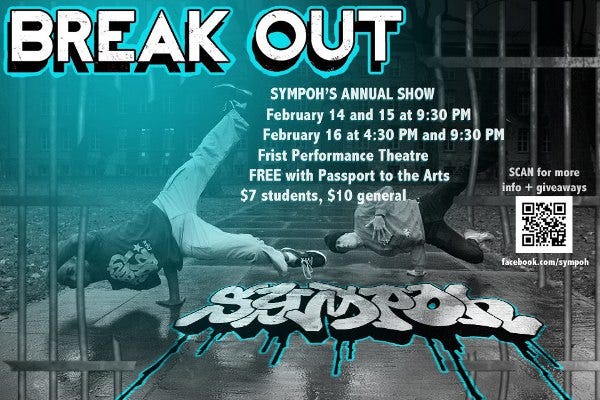A Lesson in Two Extremes
Break Out
Performed by Sympoh Urban Arts Dance Crew
Thursday (2/14) 9:30pm, Friday (2/15) 9:30pm, Saturday (2/16) 4:30pm and 9:30pm
Frist Film and Performance Theater
$7 for students, $10 for general public

April Hu is a former member of the Sympoh Urban Arts Dance Crew.
When putting on their yearly show, Sympoh faces a number of obstacles that are worth mentioning. Firstly, unlike BAC, Disiac, BodyHype, or eXpressions, Sympoh accepts a large number of students with no prior dance experience every year. In a period of roughly six months, they must not only train the newcomers in an entirely new dance form but must also prepare for a full-length show. Secondly, they must create pieces that dancers of varying experience levels are capable of learning. Thirdly, breaking is not particularly easy to choreograph, for reasons that will be discussed later on.
Break Out tries very hard to overcome these barriers, but it manages only to succeed to a very limited extent. Clocking in at roughly 1 hour and 40 minutes, the show seems inordinately long at times. There are moments when the show literally limps along, even as the dancers work desperately to keep the energy levels up. Missed cues, false starts, and severe coordination problems plague a majority of the pieces. At the performance I watched, some unprepared dancers kept staring at the people on the stage with them in an effort to recall the next sequence of moves. What, I wondered many times, is going on? Compounding my confusion were the constant references to the show title and theme of Break Out. Sympoh’s clumsy attempts to incorporate the show theme do nothing to enhance the quality of the dancing; in fact, they actually serve to detract from it by introducing unnecessary gimmicks.
I want to be clear here: this is not all Sympoh’s fault. Breakdancing is unlike other forms of dance in that it isn’t primarily a performance-based activity. The traditional venue for breakdancing is not a stage, but a battle arena. Dancers typically face one another as part of a complex competition that has strong, historical roots in improvisation. Breaking is about adapting to the beats and outdoing the opposing team or dancer, not about putting on a rehearsed show. You can imagine, then, that choreographing would be difficult, especially when the dancers aren’t technically supposed to be looking at the audience. Timing complicated footwork is even more difficult, since breakers are used to competing one on one or two on two. You don’t need to worry about coordination too much when it’s just you and one other person, but coordinating kick-outs and baby freezes with ten people on a stage is a whole different ball game. In this sense, Sympoh is given a greater challenge than dance groups that utilize more traditional, performance-oriented dance forms are.
Yet, when done correctly, choreography and breakdancing combine beautifully. David Wang ’14 presents a stunning, quiet display of precision and art in “All Mankind.” The piece begins with just three people on the stage, all done up to look like mimes. The smoothness of the transitions is a breath of fresh air on the heels of two messy opening performances. For each refrain, the dancers on the stage repeat the same sequence of motions, and you begin to understand a little bit of what David is trying to portray — aren’t we all just mimicking one another? Like mimes, you and I and the dancer without the makeup who spins slowly on the black floor seek to imitate people we’ve seen, people we wish to be.
Some other highlights include Brian Soames’ Snooze, which begins with a hilarious scene of Natasha Phidd ’13 in a bathrobe trying (and failing) to wake up a slumbering David. At one point, the two of them attempt to navigate a “sea” of swimming dancers, which undoubtedly reflects how many of us feel about waking up in the morning for class (as if we’re wading through a river of molasses). Their playfulness on the stage is really fun and doesn’t come off artificial in the way that a lot of the “comedic” moments in other pieces do. Natasha’s own piece, Got that Flava is high energy and aggressive, although there was a lighting issue that unfortunately left a portion of the dance in the dark. Ryan Armstrong’s GS Friends has some seriously impressive stunts and lifts, for those among you who enjoy things that look death-defying.
Ultimately though, Break Out suffers from being uneven in quality. The stellar pieces are clean, crisp, and a joy to watch, but their brilliance only painfully highlights those pieces that fall far short.
For seven dollars, Sympoh offers you the equivalent of Bertie Bott’s Jelly Beans. When it’s good, it’s amazing, and when it’s bad, it’s horrifying.